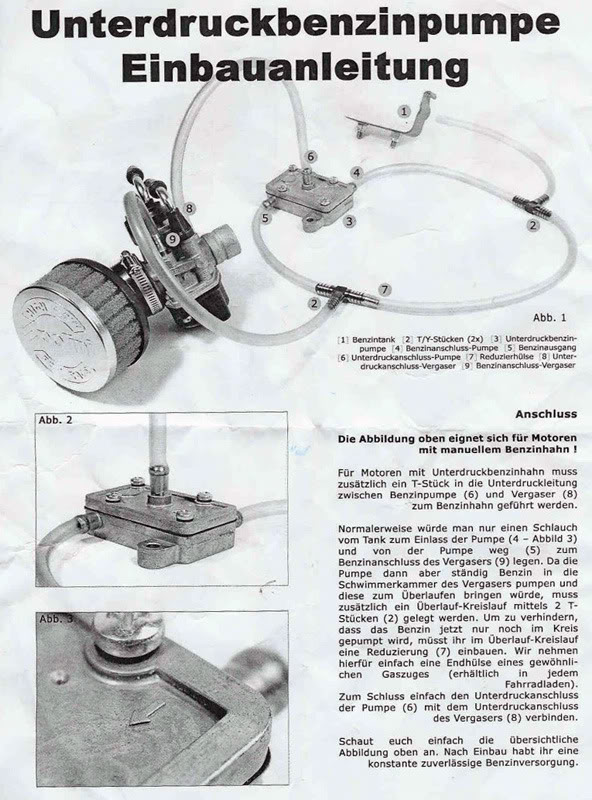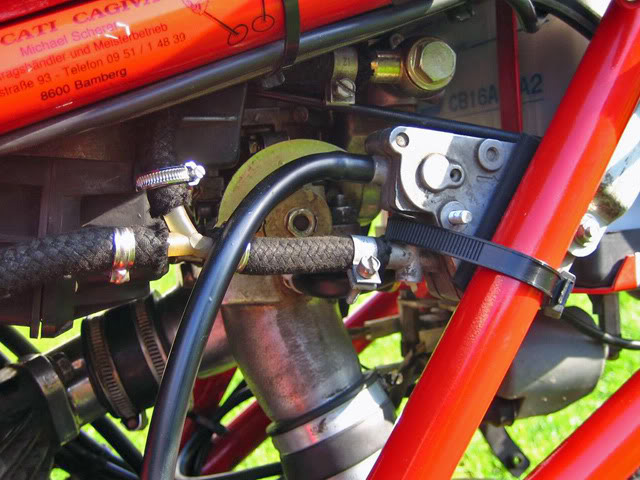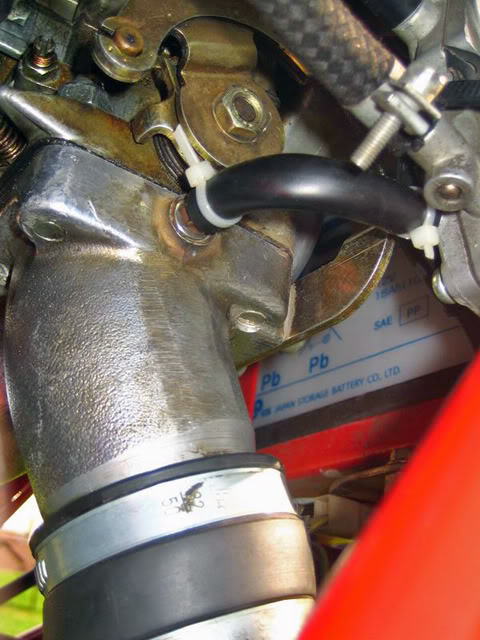I am glad you are stating that it is not an imperative that owners modify their machines to these specifications. The Weber carb standard setting gets it through EC noise and emissions tests, although not perfect it runs acceptably. Tuning the engine makes the Weber very sensitive to air temperature (air density) for one. Varying fuel pressure is a very effective method of compensating for air density (once you've got the jets correct), generally I use 3psi for temperatures below 15C lowering to 2psi above 30C. The power difference between cold and hot weather is startling, making me wonder if those injected fellows have got it quite all right. Also I must question your suggestion of increasing the air jet when increasing the main jet. Using the (πr2) formula against the chart shows that the setting 165/145 vs 190/220 gives a fuel mix almost half the final fuel volume using the larger jets! ie 165/145 is the richer setting. I tried the larger air corrector method when increasing the main jet years ago and it just would not run.
The original airbox needs the inlet snorkels or it will get air starvation above 120mph - its all very well testing these changes in a workshop when you need a wind tunnel but Ducati know their stuff and if you only ever learn one thing when trying to improve on a standard motorcycle its how good 'they' are at building them as competent all rounders.
Of course it will make good reading to hear about any mods to owner machines but I for one will now keep such alterations to myself, principally because my changes are so different to yours and it would be confusing if not misleading to have conflicting settings advertised by forum members I think.
Weberology 101 Final Exam
- romus
- Posts: 135
- Joined: Wed Mar 25, 2009 12:06 pm
- model: 906 Paso
- year: 1990
- Location: Brisbane, Australia
Re: Weberology 101 Final Exam
It is a good point. This is where the Weber lacks a "power jet", isn't it? So, there is no automatic adjustment for air density compensation on the Weber, whether by temperature or height above sea level. So changing the jetting to compensate for that is one way and changing the fuel pressure is another. I noticed a change when riding up 1,000 feet the other day - If I had a knob on my dash board attached to my Holley fuel regulator, I could have turned it slightly to reduce pressure/lean it for the height compensation -hmm.JWilliam wrote:...Tuning the engine makes the Weber very sensitive to air temperature (air density) for one. Varying fuel pressure is a very effective method of compensating for air density (once you've got the jets correct), generally I use 3psi for temperatures below 15C lowering to 2psi above 30C. The power difference between cold and hot weather is startling, making me wonder if those injected fellows have got it quite all right. ...
165/145 and 190/220 are approximately the same air fuel ratio - it is just the volume that is changing. This idea of going up a step (1 main + 3 ACs) is suggested only later in the tuning steps (after one already has the jetting pretty well right) and only if there is some slight bogging still at the very light acceleration point before the fuel pump kicks in. So, it just has the effect of getting fuel flowing just that little earlier to get that lean spot. It is not meant as a tuning idea other than that To increase volume from 165/145 to 190/220 would be far too much a jump.JWilliam wrote: Also I must question your suggestion of increasing the air jet when increasing the main jet. Using the (πr2) formula against the chart shows that the setting 165/145 vs 190/220 gives a fuel mix almost half the final fuel volume using the larger jets! ie 165/145 is the richer setting....
It is one method, along with a very slight increase in float level to resolve the Weber lean spot on slight acceleration (before the fuel pump kicks in). The taller aux venturi also must help.
Actually, we have now tested the Grose jet, and it is an even better alternative method to get that lean spot - also providing better response.
Last edited by romus on Fri Feb 19, 2010 8:33 pm, edited 4 times in total.
Warwick - on a learning curve and on a
Ducati Paso - Soul of a thoroughbred
Ducati Paso - Soul of a thoroughbred
- romus
- Posts: 135
- Joined: Wed Mar 25, 2009 12:06 pm
- model: 906 Paso
- year: 1990
- Location: Brisbane, Australia
Re: Weberology 101 Final Exam
By settings I guess you mean jetting and turns of idle screws etc and fuel pressure.JWilliam wrote:... my changes are so different to yours and it would be confusing if not misleading to have conflicting settings advertised by forum members I think..
What we have done is shown our setup info along with the jetting because yes, it is so interrelated. By using Innovate AFR sensors in line with the target AFR we show some proof of the significance of fuel pressure, airbox lid and even cam timing.
Providing our settings (as AFR tested) for those who make some or all of the mods (and we provide info on the AFR difference of various factors) provides a reference/starting point along with the reference of ones own original settings, to tune in the right direction. Otherwise, it is is easy to get lost in the tuning process.
Last edited by romus on Fri Feb 19, 2010 8:24 pm, edited 10 times in total.
Warwick - on a learning curve and on a
Ducati Paso - Soul of a thoroughbred
Ducati Paso - Soul of a thoroughbred
- higgy
- paso grand pooh-bah
- Posts: 3329
- Joined: Tue Jul 29, 2008 9:50 pm
- model: 907 I.E.
- year: 1992
- Location: Hilltown,Pennsylvania
- Contact:
Re: Weberology 101 Final Exam
Depends on the system. Computerized feedback systems rule. early systems like found on the 907 needed a lot of tweaking.making me wonder if those injected fellows have got it quite all right.
It is all about what you can measure and accurately respond to in a repeatable fashion. comes down to the quality of your sensors and the response time of your software
But none of that matters much on a carb system, does it?
Ducati,making mechanics out of riders since 1946
There's no problem so bad that a little fixing can't make it worse! : )
If it ain't broke keep fixin it till it is
88 750
90 906
92 907ie
There's no problem so bad that a little fixing can't make it worse! : )
If it ain't broke keep fixin it till it is
88 750
90 906
92 907ie
- paso750
- paso grand pooh-bah
- Posts: 5558
- Joined: Sun Jul 18, 2004 12:00 am
- model: 750 Paso
- year: 1987
- Location: southern Germany
Re: Weberology 101 Final Exam
the correct name is I guess a diaphragm fuelpump.
basic setup (7 is a reducing bush, 2 is not required if the tank has a return line)

I found the webpage ( http://www.8ung.at/manxman/ ). The guy used one from an old Yamaha TDM850 (Duc Monster also use them). He used one of the connections for the sync tester on the side of the inlet manifold and put in a screwing nipple he connected the fuel pump to. (actually he used a M4 thread rod, drilled it though and glued a nut onto it). He says that the pulsatory suction process moves the diaphragm and delivers the fuel evenly independend of rpm which corresponds to what higgy had said. So I guess I was wrong again. Still worth a try though.


basic setup (7 is a reducing bush, 2 is not required if the tank has a return line)

I found the webpage ( http://www.8ung.at/manxman/ ). The guy used one from an old Yamaha TDM850 (Duc Monster also use them). He used one of the connections for the sync tester on the side of the inlet manifold and put in a screwing nipple he connected the fuel pump to. (actually he used a M4 thread rod, drilled it though and glued a nut onto it). He says that the pulsatory suction process moves the diaphragm and delivers the fuel evenly independend of rpm which corresponds to what higgy had said. So I guess I was wrong again. Still worth a try though.


-
Tamburinifan
- paso grand pooh-bah
- Posts: 1527
- Joined: Thu Jun 21, 2007 12:00 am
- model: 907 I.E.
- year: 1991
- Location: Gothenburg, SWEDEN
Re: Weberology 101 Final Exam
We have Air temp compensation in software.The power difference between cold and hot weather is startling, making me wonder if those injected fellows have got it quite all right.
At +10 C you get like 5-10% more fuel than at +30 C, generally speaking.
In starting procedure, it could vary 30-50% between 10 & 30C.
Gert
907 I.E. -91
M900 -97
MTS 1100s -07
907 I.E. -91
M900 -97
MTS 1100s -07
-
Mc tool
- paso grand pooh-bah
- Posts: 1878
- Joined: Wed Dec 05, 2007 12:35 am
- model: 906 Paso
- year: 1990
- Location: Newzealand
Re: Weberology 101 Final Exam
quote Higgy
At the moment I have a 195 Cummins engine going for a baseline test.
Its a diesel but just as an example........
Cant see the point in that Higgy, It doesnt even use a webber and you'll never get it in a paso!
At the moment I have a 195 Cummins engine going for a baseline test.
Its a diesel but just as an example........
Cant see the point in that Higgy, It doesnt even use a webber and you'll never get it in a paso!
I wish I was young again............Id be heaps smarter than last time
- higgy
- paso grand pooh-bah
- Posts: 3329
- Joined: Tue Jul 29, 2008 9:50 pm
- model: 907 I.E.
- year: 1992
- Location: Hilltown,Pennsylvania
- Contact:
Re: Weberology 101 Final Exam
Is that a triple dog dare? 







Ducati,making mechanics out of riders since 1946
There's no problem so bad that a little fixing can't make it worse! : )
If it ain't broke keep fixin it till it is
88 750
90 906
92 907ie
There's no problem so bad that a little fixing can't make it worse! : )
If it ain't broke keep fixin it till it is
88 750
90 906
92 907ie
-
Mc tool
- paso grand pooh-bah
- Posts: 1878
- Joined: Wed Dec 05, 2007 12:35 am
- model: 906 Paso
- year: 1990
- Location: Newzealand
Re: Weberology 101 Final Exam
I think that Jesse James pillock put one in a trike , or more correctly destroyed a perfectly good truck to the point that he had to call it a trike 
I wish I was young again............Id be heaps smarter than last time
- JWilliam
- Posts: 331
- Joined: Wed Oct 06, 2004 12:00 am
- model: 906 Paso
- year: 1989
- Location: Nottingham, UK
Re: Weberology 101 Final Exam
Well I run my engine at a lower temperature, certainly have different jet setings and can manually alter fuel pressure on the fly for a start. So as I said to Higgy via a pm the document is a super production but Paso owners should work through this and make their minds up rather than another owner offer conflicting setings and create possible confusion. But you have made this a public document and I am duty bound to state that under some subjects I disagree.
romus wrote:By settings I guess you mean jetting and turns of idle screws etc and fuel pressure.JWilliam wrote:... my changes are so different to yours and it would be confusing if not misleading to have conflicting settings advertised by forum members I think..
What we have done is shown our setup info along with the jetting because yes, it is so interrelated. By using Innovate AFR sensors in line with the target AFR we show some proof of the significance of fule pressure, airbox lid and even cam timing.
